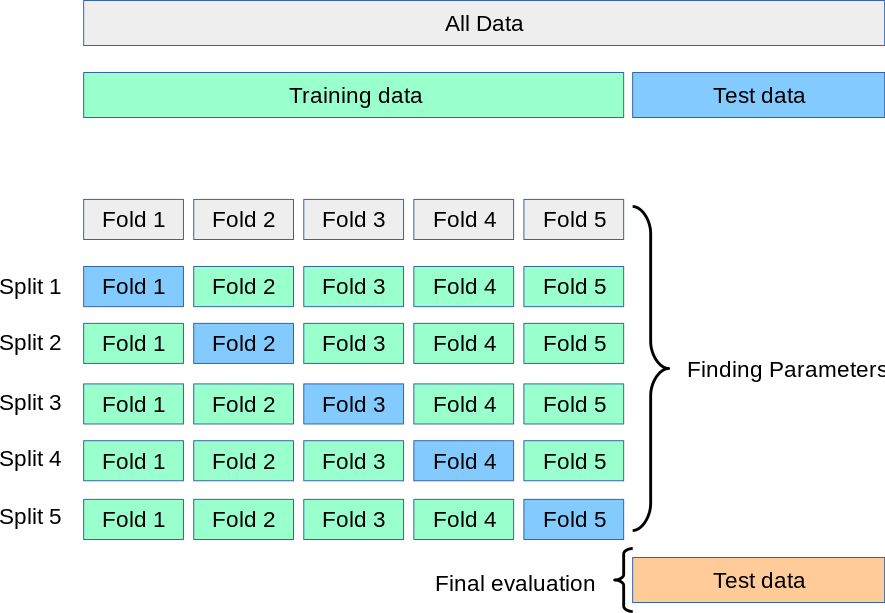Chapter 12 The basics of machine learning

The machine learning flow. source: mlr3 manual
Data: \[(y_i,\bf{x}_i)_{i=1,\dots,N}\] where \(\bf{x}\in\mathbb{R}^D\).
Want to predict \(y\) from \(\bf{x}\).
Model for prediction: \[f(\bf{x})=\theta^T\bf{x}+\theta_0\]
12.1 Training vs prediction
12.1.1 Training vs testing (predicting) sets
- The entire sample \(\mathcal{S}=(y_i,\bf{x}_i)_{i=1,\dots,N}\) is randomly separatedly to two disjoint sets of sample, say \(\mathcal{S}_t\) and \(\mathcal{S}_p\), so that
\[\mathcal{S}_t\cup\mathcal{S}_p=\mathcal{S},\ \mathcal{S}_t\cap\mathcal{S}_p=\mathcal{S}\]
Model training phase: when you are estimating parameters using \(\mathcal{S}_t\).
Model testing phase: when you are evaluating your model performance using \(\mathcal{S}_p\).
12.2 How to train a model
some measure of quality:
- empirical risk minimization: such as SSE
\[\min_{\theta,\theta_0}\ \sum_{(y_i,\bf{x}_i)\in\mathcal{S}_t}(y_i-f(\bf{x_i}|\theta,\theta_0))^2/N\]
- Bayesian inference
12.3 Training while avoiding over/under-fitting
- Training without proper reigning will lead to a trained model that performs well in \(\mathcal{S}_t\), but poorly in \(\mathcal{S}_p\).
You want to predict head or tail from a coin tossing. You collect a sample of \((H,T,H,H,H)\). Randomly separate it into \(\mathcal{S}_t=(H,H,H)\) and \(\mathcal{S}_p=(H,T)\).
What is your model?
What is your measure of quality?
What is your parameter estimate?
12.3.1 Reigning while training
- Regularization: add penalty term (call regularizer) to our loss function, such as \(\left\Vert \bf{\theta}\right\Vert^2\), with a tunning parameter \(\lambda\). For example,
\[ \min_{ \bf{\theta}}\ \sum_{(y_i,\bf{x}_i)\in\mathcal{S}_t}(y_i-f(\bf{x_i}| \bf{\theta}))^2/N + \lambda\left\Vert \bf{\theta}\right\Vert^2, \ or \] \[ \min_{ \bf{\theta}}\ \left\Vert \bf{y}-f(\bf{x}| \bf{\theta})\right\Vert^2/N + \lambda\left\Vert \bf{\theta}\right\Vert^2, \] where \(\lambda>0\) is called a tunning parameter that needs to be chosen in the training phase as well.
- Addinng a prior
12.3.2 Cross-validation to choose tunning parameter
12.4 Python example
Intall the basic Python machine learning package:
- cross-validation: https://scikit-learn.org/stable/model_selection.html#model-selection

- Regularization of Linear Regression Model:
- Ridge regression
\[\min_{w} || X w - y||_2^2 + \alpha ||w||_2^2\]
linear_model.Ridge(alpha=0.5) # instance initiation linear_model.RidgeCV()- Lasso regression
\[\min_{w} { \frac{1}{2n_{\text{samples}}} ||X w - y||_2 ^ 2 + \alpha ||w||_1}\]
linear_model.Lasso() # instance initiation - Ridge regression
- Stochastic Gradient Descent:
- SGDRegressor:
a batch size of 1, stochastic gradient descent algorithm.
SGDRegressor( loss="squared_loss", # OLS Loss function panelty="l2", # squared norm of parameters alpha=0.0001 )其他參數還有max_it(全部data可pass through的次數,即epoch,上限),
\[Sample\ size(1000) / Batch\ size (250) = Iteration\ times (4)\] One epoch is one complete sample size passing through, which requires four iterations to complete.
- SGDRegressor:
## choose your model class
from sklearn.linear_model import LinearRegression, Ridge, RidgeCV, Lasso, LassoCV, SGDRegressor
## choose your metrics
from sklearn.metrics import mean_squared_error, r2_score
## training-test split
from sklearn.model_selection import train_test_splitimport numpy as np
import matplotlib.pyplot as plt
rng=np.random.default_rng(seed=2019) # initiate a random generator with seed 2019, for replication purpose
x = rng.normal(size=30)
y = 0 +0.1* x + 0.33*rng.normal(size=x.shape)
X=np.column_stack(
(np.ones(x.shape),x,x**2,x**3)
)
X_train, X_test, y_train, y_test = train_test_split(X, y, test_size=0.25, random_state=42)12.4.1 模型設定
# Linear regression
Linear1=LinearRegression()
# Ridge regression
Ridge1=Ridge(alpha=0.5)
Ridge2=RidgeCV(alphas=np.linspace(0.1,3,10), cv=5) # 5-fold cv
# Lasso regression
Lasso1=Lasso(alpha=0.5)
Lasso2=LassoCV(alphas=np.linspace(0.1,3,10), cv=5) # 5-fold cv
# SGD regression
SGD1=SGDRegressor()
SGD2=SGDRegressor()12.4.2 Training
## LinearRegression(copy_X=True, fit_intercept=True, n_jobs=None, normalize=False)## Ridge(alpha=0.5, copy_X=True, fit_intercept=True, max_iter=None,
## normalize=False, random_state=None, solver='auto', tol=0.001)## RidgeCV(alphas=array([0.1 , 0.42222222, 0.74444444, 1.06666667, 1.38888889,
## 1.71111111, 2.03333333, 2.35555556, 2.67777778, 3. ]),
## cv=5, fit_intercept=True, gcv_mode=None, normalize=False, scoring=None,
## store_cv_values=False)
##
## //anaconda3/envs/m-team/lib/python3.7/site-packages/sklearn/model_selection/_search.py:814: DeprecationWarning: The default of the `iid` parameter will change from True to False in version 0.22 and will be removed in 0.24. This will change numeric results when test-set sizes are unequal.
## DeprecationWarning)## Lasso(alpha=0.5, copy_X=True, fit_intercept=True, max_iter=1000,
## normalize=False, positive=False, precompute=False, random_state=None,
## selection='cyclic', tol=0.0001, warm_start=False)## LassoCV(alphas=array([0.1 , 0.42222222, 0.74444444, 1.06666667, 1.38888889,
## 1.71111111, 2.03333333, 2.35555556, 2.67777778, 3. ]),
## copy_X=True, cv=5, eps=0.001, fit_intercept=True, max_iter=1000,
## n_alphas=100, n_jobs=None, normalize=False, positive=False,
## precompute='auto', random_state=None, selection='cyclic', tol=0.0001,
## verbose=False)## SGDRegressor(alpha=0.0001, average=False, early_stopping=False, epsilon=0.1,
## eta0=0.01, fit_intercept=True, l1_ratio=0.15,
## learning_rate='invscaling', loss='squared_loss', max_iter=1000,
## n_iter_no_change=5, penalty='l2', power_t=0.25, random_state=None,
## shuffle=True, tol=0.001, validation_fraction=0.1, verbose=0,
## warm_start=False)n_batches = 3
(n, m)=X_train.shape
split_index=np.arange(0,n,1)
rng.shuffle(split_index) # 洗牌
for slice_index in np.array_split(split_index, n_batches):
SGD2.partial_fit(X_train[slice_index,:],y_train[slice_index])## SGDRegressor(alpha=0.0001, average=False, early_stopping=False, epsilon=0.1,
## eta0=0.01, fit_intercept=True, l1_ratio=0.15,
## learning_rate='invscaling', loss='squared_loss', max_iter=1000,
## n_iter_no_change=5, penalty='l2', power_t=0.25, random_state=None,
## shuffle=True, tol=0.001, validation_fraction=0.1, verbose=0,
## warm_start=False)
## SGDRegressor(alpha=0.0001, average=False, early_stopping=False, epsilon=0.1,
## eta0=0.01, fit_intercept=True, l1_ratio=0.15,
## learning_rate='invscaling', loss='squared_loss', max_iter=1000,
## n_iter_no_change=5, penalty='l2', power_t=0.25, random_state=None,
## shuffle=True, tol=0.001, validation_fraction=0.1, verbose=0,
## warm_start=False)
## SGDRegressor(alpha=0.0001, average=False, early_stopping=False, epsilon=0.1,
## eta0=0.01, fit_intercept=True, l1_ratio=0.15,
## learning_rate='invscaling', loss='squared_loss', max_iter=1000,
## n_iter_no_change=5, penalty='l2', power_t=0.25, random_state=None,
## shuffle=True, tol=0.001, validation_fraction=0.1, verbose=0,
## warm_start=False)12.4.3 Predict
# Linear regression
y_predictLinear1=Linear1.predict(X_test)
# Ridge regression
y_predictRidge1=Ridge1.predict(X_test)
y_predictRidge2=Ridge2.predict(X_test) # 5-fold cv
# Lasso regression
y_predictLasso1=Lasso1.predict(X_test)
y_predictLasso2=Lasso2.predict(X_test) # 5-fold cv
# SGD regression
y_predictSGD1=SGD1.predict(X_test)
y_predictSGD2=SGD2.predict(X_test)12.4.4 accuracy
mseLinear1=mean_squared_error(y_test,y_predictLinear1)
# Ridge regression
mseRidge1=mean_squared_error(y_test,y_predictRidge1)
mseRidge2=mean_squared_error(y_test,y_predictRidge2) # 5-fold cv
# Lasso regression
mseLasso1=mean_squared_error(y_test,y_predictLasso1)
mseLasso2=mean_squared_error(y_test,y_predictLasso2) # 5-fold cv
# SGD regression
mseSGD1=mean_squared_error(y_test,y_predictSGD1)
mseSGD2=mean_squared_error(y_test,y_predictSGD2){"mseLinear1": mseLinear1,
# Ridge regression
"mseRidge1": mseRidge1,
"mseRidge2": mseRidge2,
# Lasso regression
"mseLasso1": mseLasso1,
"mseLasso2": mseLasso2,
# SGD regression
"mseSGD1": mseSGD1,
"mseSGD2": mseSGD2
}## {'mseLinear1': 0.23913965444458862, 'mseRidge1': 0.22923260522059308, 'mseRidge2': 0.20688285341153212, 'mseLasso1': 0.164949079025128, 'mseLasso2': 0.17400205980219802, 'mseSGD1': 0.18901352025558144, 'mseSGD2': 0.15951178277143552}